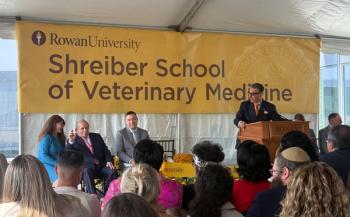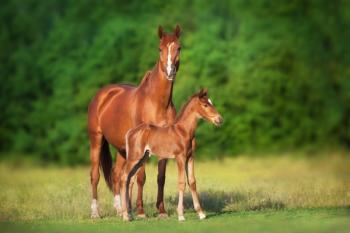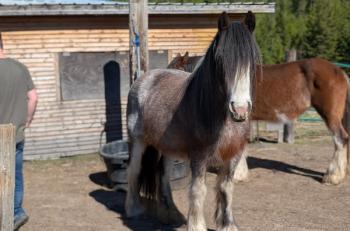
Overweight horses: An increasing problem
Using grazing muzzles may help limit intake and reduce the chance of overfeeding.
It's that time of the year again—daylight savings time, tax time, time to deal with fresh spring grass pastures. And it's time to deal with the problem of the overweight horse. This problem has been growing just about as fast as the girth size of these "easy-keepers." And each spring, when carbohydrate-rich grass threatens to cause laminitis, metabolic syndrome flare-ups and other obesity-related conditions, practitioners must do their best to keep things under control.
A look at the scale of obesity
The first study to look at the problem of the overweight horse was done in 1998 by the National Animal Health Monitoring System for the United States Department of Agriculture, which estimated that roughly 5 percent of horses in America at that time were overweight.
Time for the lush life: Spring grass is carbohydrate-rich and can make horses quickly pack on the pounds. (Photo courtesy of Dr. Marcella)
A 2006 study undertaken at the Virginia-Maryland Regional College of Veterinary Medicine showed that, in eight years, that number had skyrocketed to 51 percent, with 19 percent of those horses classified as obese.1 "The majority of horses in this study were fed primarily pasture and hay with very little grain or concentrate," reported Craig Thatcher, a veterinary nutritionist who was one of the researchers.
A more recent study done in 2011 at the University of Nottingham in England found that nearly 54 percent of the horses examined were overweight.2 This study showed that, again, most of these animals were maintained on grass and hay, proving that grain or concentrates are not needed to produce an overfed horse and that pasture grass intake must be carefully regulated in order to realistically manage body weight.
Walking the pasture: Sufficient exercise?
There is nothing inherently wrong with pasture grass for horses. But because horses are so good at grazing and today's grasses contain such high amounts of carbohydrates, problems inevitably occur. The typical horse at pasture spends roughly 70 percent of its time, or 17 out of every 24 hours, engaged in some form of grazing behavior. The remaining 30 percent is devoted to sleep (one to two hours each day), play, socialization and various assorted herd behaviors. The type and quality of the pasture greatly influences grazing time.
Raymond Geor, BVSc, MVSc, PhD, Dipl. ACVIM, of the College of Veterinary Medicine at Michigan State University explains that, on average, 10 percent of a horse's day is spent walking at pasture looking for food. The poorer the pasture, the more time spent looking for edible and palatable forage, so horses will spend less time grazing on a lush spring pasture than they will on a mid- to late-summer pasture with poorer quality grass. This pasture quality difference translates, therefore, into a difference in voluntary exercise as well.
Rather than being consistent with a work program of light riding, lunging or other exercise, clients often try to offer up their horses' walking out on pasture as a method of controlling excess weight. It turns out that there is, in fact, some scientific truth to this general wishful thinking after all.
Researchers at the Equine Science Division of the Hidaka Training and Research Center (a part of the Japanese Racing Association) conducted a study in yearling Thoroughbreds and looked at the effects of grazing time on feed intake and energy expenditure.3 They found that horses that were allowed to graze for 17 hours daily on a 10-acre field travelled between 8 and 9.5 miles and burned substantially more calories than horses allowed to graze for only seven hours on the same field. Those horses travelled only 2.5 to 3 miles, with proportionally less energy expended.
While these distances walked and the energy used sound encouraging in principal, they must be counterbalanced by the effects of grazing for that one-hour period because horses are quite capable of walking with their mouths full. When the actual numbers are run, there turns out to be little overall benefit in dietary management achieved by leaving horses out on pasture for extended periods. There certainly are other beneficial reasons for more turnout time (e.g., reduced colic, better joint health), but we are speaking purely nutritionally in this instance. While all that excess walking around the pasture and grazing does use up more calories, these horses also consume more calories eating for 17 hours straight. They actually end up with higher carbohydrate intake.
Geor provides data supporting the fact that a horse at pasture 24 hours a day and grazing 17 hours out of that time will generally consume up to 25 lb of forage. Since a mature horse needs to consume 2 to 2.5 percent of its body weight daily, this 25 lb of forage is more than enough for maintenance needs. If this horse were to be fed any additional feed or concentrates, then it would be overfed, and such management would be contributing to the problem of obesity.
Reduced pasture time: A good solution?
It seems fairly intuitive then that the best means of controlling a horse's carbohydrate intake is to limit its access to pasture, especially lush green pasture. If you drastically limit a horse's access to green grass, so the thinking goes, then you drastically reduce its intake and its chances of overeating.
Paul Siciliano, a PhD nutritionist in the Department of Animal Sciences at North Carolina State College of Veterinary Medicine, recently presented new information at a nutritional short course that calls this reduced pasture time theory into question. Siciliano's work showed that if you reduce the pasture time available for grazing by a particular horse, then that horse generally responds by increasing its grazing intake, so the overall carbohydrate consumed is roughly equal. Some exceptionally motivated horses in Sicilano's study were able to consume 17 hours' worth of grass intake in only three hours of turnout, assuming that quantity was not limited. Thus, simply limiting turn out will not work.
Grazing muzzles
Another option for controlling overweight horses in the spring grass season is to limit intake, and the equine grazing muzzle makes that approach possible. Grazing muzzles greatly reduce the bite size that horses can take, and they make individual horses spend a greater proportion of time engaged in foraging behavior (more walking, less eating).
A recent study conducted in Wales, U.K., showed that pasture intake by ponies wearing muzzles was only 0.14 percent of body weight over three hours, which amounts to an 83 percent reduction compared with non-muzzle-wearing horses.4
Another study by Tracey Hammond, a nutritionist for Dengie Feeds, demonstrated a restricted grass intake with a grazing muzzle of 75 to 86 percent. "Muzzled horses had a 50 percent reduction in bite depth and a 62 percent reduction in bite weight, which is likely to provide the strongest evidence for how and by how much a muzzle restricts intake," says Hammond. Horses wearing a muzzle simply cannot bite as deeply or get as big of a bite as horses that are not wearing one.
There are many different designs for grazing muzzles, and proper, comfortable fit is important. Most manufacturers recommend that muzzles remain in place for no longer than 12 hours at a time.
"Grazing muzzles appear to be an effective method of restricting pasture intake," says Clare Barfoot, one of the researchers of the study on muzzle use in the U.K. "The study has given us helpful, practical guidance on how we can safely manage grass intake to control weight gain and reduce the risk of obesity-related disorders, without significantly compromising the natural behavior and wellbeing of our horses and ponies."
When it comes to spring green grass, it truly is a case for "less means more," and a well-fitting grazing muzzle may be the answer.
Dr. Marcella is an equine practitioner in Canton, Ga.
References
1. Thatcher CD, Pleasant RS, Geor RJ, et al. Prevalence of obesity in mature horses: an equine body condition study. J Anim Physiol Anim Nutr 2008;92(2):222.
2. Stephenson HM, Green MJ, Freeman SL. Prevalence of obesity in a population of horses in the UK. Vet Rec 2011;168(5):131.
3. Asai Y, Matsui A, Osawa T, et al. Digestible energy expenditure in grazing activity of growing horses. Equine Vet J Suppl 1999;30:490-492.
4. Longland A, Harris P, Barfoot C. The effect of wearing a grazing muzzle vs. not wearing a grazing muzzle on pasture dry matter intake by ponies. J Equine Vet Sci 2011;31(5):282-283.
Newsletter
From exam room tips to practice management insights, get trusted veterinary news delivered straight to your inbox—subscribe to dvm360.






